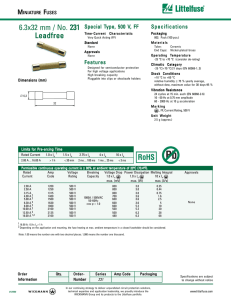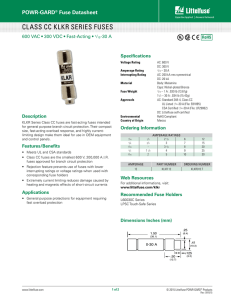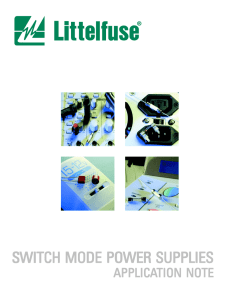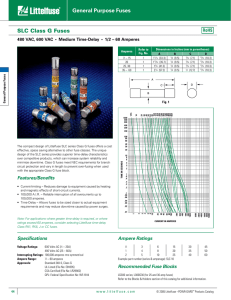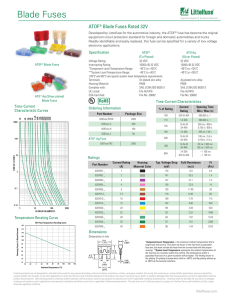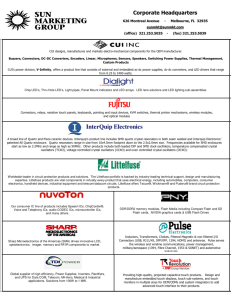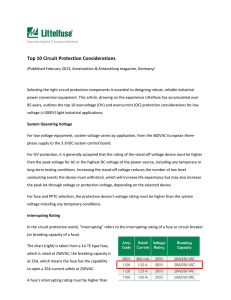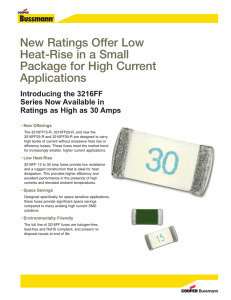Recommendations for Re-Energizing Flood-Damaged
advertisement
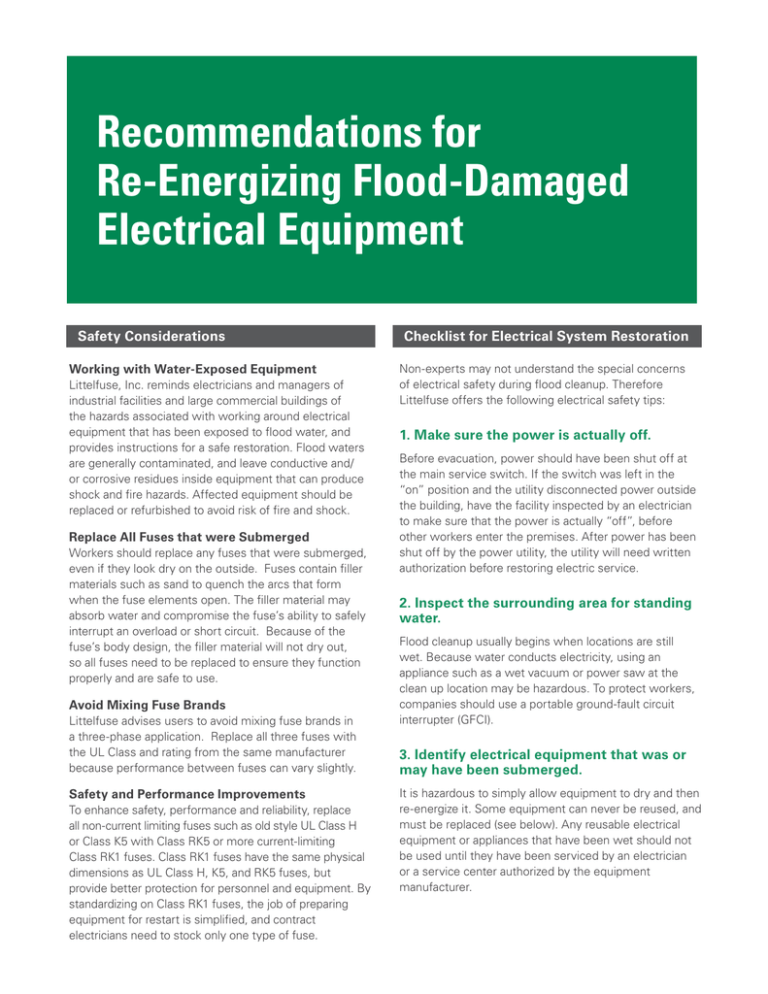
Recommendations for Re-Energizing Flood-Damaged Electrical Equipment Safety Considerations Working with Water-Exposed Equipment Littelfuse, Inc. reminds electricians and managers of industrial facilities and large commercial buildings of the hazards associated with working around electrical equipment that has been exposed to flood water, and provides instructions for a safe restoration. Flood waters are generally contaminated, and leave conductive and/ or corrosive residues inside equipment that can produce shock and fire hazards. Affected equipment should be replaced or refurbished to avoid risk of fire and shock. Replace All Fuses that were Submerged Workers should replace any fuses that were submerged, even if they look dry on the outside. Fuses contain filler materials such as sand to quench the arcs that form when the fuse elements open. The filler material may absorb water and compromise the fuse’s ability to safely interrupt an overload or short circuit. Because of the fuse’s body design, the filler material will not dry out, so all fuses need to be replaced to ensure they function properly and are safe to use. Avoid Mixing Fuse Brands Littelfuse advises users to avoid mixing fuse brands in a three-phase application. Replace all three fuses with the UL Class and rating from the same manufacturer because performance between fuses can vary slightly. Safety and Performance Improvements To enhance safety, performance and reliability, replace all non-current limiting fuses such as old style UL Class H or Class K5 with Class RK5 or more current-limiting Class RK1 fuses. Class RK1 fuses have the same physical dimensions as UL Class H, K5, and RK5 fuses, but provide better protection for personnel and equipment. By standardizing on Class RK1 fuses, the job of preparing equipment for restart is simplified, and contract electricians need to stock only one type of fuse. Checklist for Electrical System Restoration Non-experts may not understand the special concerns of electrical safety during flood cleanup. Therefore Littelfuse offers the following electrical safety tips: 1. Make sure the power is actually off. Before evacuation, power should have been shut off at the main service switch. If the switch was left in the “on” position and the utility disconnected power outside the building, have the facility inspected by an electrician to make sure that the power is actually “off”, before other workers enter the premises. After power has been shut off by the power utility, the utility will need written authorization before restoring electric service. 2. Inspect the surrounding area for standing water. Flood cleanup usually begins when locations are still wet. Because water conducts electricity, using an appliance such as a wet vacuum or power saw at the clean up location may be hazardous. To protect workers, companies should use a portable ground-fault circuit interrupter (GFCI). 3. Identify electrical equipment that was or may have been submerged. It is hazardous to simply allow equipment to dry and then re-energize it. Some equipment can never be reused, and must be replaced (see below). Any reusable electrical equipment or appliances that have been wet should not be used until they have been serviced by an electrician or a service center authorized by the equipment manufacturer. Re-Energizing Flood-Damaged Equipment 4. Inspect electrical equipment that was not submerged. 9. Inspect motor control equipment and replace or refurbish. Even if electrical equipment was not submerged, it should be inspected by a qualified person to determine whether moisture has entered the enclosures. Components containing semiconductors and transistors must be replaced. This includes electronically controlled and solid state contactors and starters. Overload relays must also be replaced. Some motor control equipment can be refurbished and reused. Adjustable speed drives (not the electronic kind) can be saved, as well as manual and magnetic controllers and motor control centers. 5. Replace or refurbish large electrical equipment: •Switchgear •Panelboards • 10. Inspect power equipment. Motor control centers Electronic trip units of low voltage power breakers must be replaced. High-voltage circuit breakers (AC); low voltage power circuit breakers; protective relays, meters, and current transformers may be refurbished and reused, as may low voltage and medium voltage switchgear. •Motors •Transformers 6. Replace small components of wiring infrastructure: •Receptacles 11. Replace dry-type transformers, and analyze liquid-filled transformers. •Switches • Light fixtures All dry-type transformers regardless of kVA ratings, all dry-type control circuit transformers and all castresin transformers must be replaced. For liquid-filled transformers, analysis of the insulating medium is required for evaluation. •Dimmers 7. Replace circuit protection devices and power distribution devices: •Fuses • 12. Replace wire, cable or flexible cord Disconnect switches Wire or cable listed for dry locations (such as NM-B) must be replaced. Wire or cable that is suitable for wet locations may be refurbished and reused, provided the ends of the wire or cable have not been exposed to water and the wire is not damaged. •GFCIs • Arc fault circuit interrupters • Surge protection devices • Molded case circuit breakers 13. Replace or refurbish other devices. 8. Examine busways and replace or recondition them. Signaling, protection and communications systems must be replaced. Cable trays (replace damaged labels), fire pump controllers and motors may be refurbished and reused. Busways with powder coated bars may be reconditioned and reused. Busway with Mylar wrapped bars must be replaced, since water and corrosive contaminants cannot be removed effectively from beneath the wrapping. littelfuse.com 2 © 2014 Littelfuse POWR-GARD® Products Catalog Re-Energizing Flood-Damaged Equipment NEMA Guidelines: Additional Information: More detailed information on what equipment may be refurbished and reused and what must be replaced is available in a set of NEMA guidelines entitled “Evaluating Water-Damaged Electrical Equipment.” The full text is available from NEMA at: www.nema.org/stds/water-damaged.cfm#download About Littelfuse – As the worldwide leader in circuit protection products and solutions with annual sales of $530.8 million in 2008, the Littelfuse portfolio is backed by industry leading technical support, design and manufacturing expertise. Littelfuse products are vital components in virtually every product that uses electrical energy, including automobiles, computers, consumer electronics, handheld devices, industrial equipment, and telecom/datacom circuits. The POWR-GARDTM business unit specializes in fuses for construction and industrial applications. POWR-GARD offers a full line of fuses, ground fault relays and electrical safety services to enhance the protection of workers and equipment from electrical incidents. For more information, please visit Littelfuse’s Web site at www.littelfuse.com. Summary: Littelfuse would like to stress the importance of following these and other necessary safety precautions when working on flood-damaged electrical equipment. The conditions this environment presents make this a time to be especially aware of safety procedures. Following this checklist for electrical system restoration will reduce hazards for both equipment and personnel. Littelfuse 24 Hour Emergency Hotline: 847-824-1188 Our Emergency Fuse Service is available 24 hours a day, seven days a week - even on holidays. Technical Support: 1-800-TEC-FUSE (800-832-3873) For more information on replacing water-damaged fuses, call the Littelfuse Technical Support line. For more a more information on any of Littelfuse’s circuit protection devices or to cross-reference fuse part numbers, visit the Littelfuse website at littelfuse.com © 2014 Littelfuse POWR-GARD® Products Catalog 3 littelfuse.com © 2014, Littelfuse Inc. 800-TEC-FUSE | www.littelfuse.com
